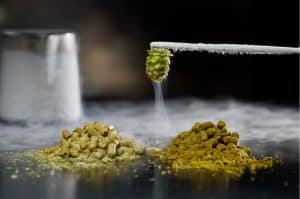 What are Cryo Hops?
What are Cryo Hops?
Before diving right into the swirling whirlpool of Cryo Hops, let’s first look at how hops are used in brewing.
Hops are one of the 4 essential ingredients in beer, along with water, yeast and barley. Brewers may use either whole cone or pelletized hops, where whole cones are kept intact, pelletized hops are milled and compressed. While whole cone hops are ideal for certain recipes, pelletized hops are more practical, as they are both easier to use and to store.
T-90 are the most commonly used type of hop pellet, where T-90 stands for “Type 90,” that is composed of 90 percent green matter and 10 percent lupulin. Green matter refers to the outside leafage of the hop cone, also referred to as bract. The yellow pollen-like substance in the middle of the hop cone are the lupulin glands, that contain hop acids and essential oils.
With the meteoric rise of New England IPAs and higher hopping rates, brewers began using significantly more hops to produce their beer. To take advantage of the highly coveted lupulin, some hop farmers have started packaging pellets with more lupulin than green material, often referred to as “lupulin-enriched products.”
In 2014, Yakima Chief Hops launched a pilot program to produce their lupulin-enriched pellet. The program has since grown exponentially, and this past year they generated six million pounds of their now proprietary Cryo Hops.
Derived from the Greek word kryos, meaning frost, YCH starts with fresh hop bales and uses liquid nitrogen to quickly chill fresh hops to sub-zero temperatures. At this point, the hops are shattered, and the pollen-like lupulin glands start to separate like grains of sand. The bract, or leaf material is sifted away, before the lupulin is pressed into cryo hop pellets.
Why Use Cryo Hops?
Cryo Hops are most often used in hoppy, hazy beers, as they enhance the flavour and aroma of the beer, while minimizing the grassy, vegetal, and astringent nature found in traditionally processed whole cone or pelletized hops. While more expensive than other pelletized hops, brewers can use about half the amount of Cryo Hops as they would traditional pellets.
In addition to boosting the final flavour of the beer, Cryo Hops also prevent yield loss. During the brewing process, the leafy green bract absorbs liquid, where the lupulin does not. Brewers can create a heavily hopped, super aromatic beer without losing a lot of product.
While lupulin-enriched products may be an excellent addition to a hazy or milkshake IPA, they are not the perfect one-hop-fits-all solution. Some beer styles may be overwhelmed by the intensity of Cryo Hops, and will instead benefit from more delicate, and/or cleaner hop additions. Lupulin-enhanced products also form far fewer iso-alpha-acids than regular hop pellets, meaning they will produce less bitterness in the final brew. All that said, Cryo Hops have created incredible opportunities for new, innovative brews while minimizing product loss.
(Leah is a Toronto based freelance writer as well as the Beer Boss and a server at C’est What)
 What are Cryo Hops?
What are Cryo Hops?